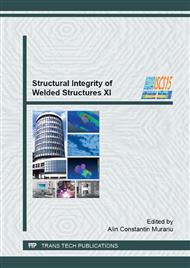p.62
p.67
p.73
p.79
p.85
p.91
p.97
p.103
p.110
Effect of Heat Treatment on the Surfaces Topography Tested at the Cavitation Erosion from Steel 16MnCr5
Abstract:
This paper analyzes, by comparison, the changes appeared in surface topography, for 16MnCr5 steel tested at cavitation erosion, subjected to different type of the heat treatments. The purpose of research, aimed at establishing a correlation between resistance to cavitation erosions and the surface roughness parameters, for various types of heat treatment (annealing, carburizing, Duplex treatment of carburizing, followed by the surface hardening by induction). Cavitation tests were conducted on a vibrator device with piezoceramic crystals, which fully complies with the requirements imposed by the ASTM G32 - 2010. Roughness parameters were measured using a Mitutoyo apparatus.
Info:
Periodical:
Pages:
85-90
Citation:
Online since:
July 2015
Keywords:
Price:
Сopyright:
© 2015 Trans Tech Publications Ltd. All Rights Reserved
Share:
Citation:


